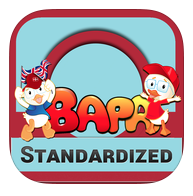I was pretty excited to have the opportunity to review Smarty Speech’s new assessment app the ITAP. 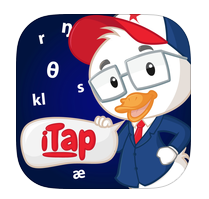
Disclosure statement: I received a copy of this app for free for the purpose of review. The opinions expressed here are my own. The ITAP is a standardized articulation assessment for the iPad. The website states it can be used for students of any age. It is standardized for students up to age 10, 11.
ITAP Administration
All of the stimuli are full color photos, which makes it accessible to a variety of ages. You can press the play button in the corner for the students to hear the word. The phonetic transcription is written at the top of the page. After the student has said the word, they receive feedback (fabulous, bravo, way to go etc).
You can customize this app to meet your needs:
- turning the feedback on/off
- recording the students productions
- writing a note on the students productions
- showing or hiding the labels
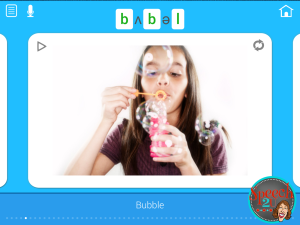
After the child says the word, you click on error phoneme and report the type of error. If you click on substitution, a list of phonemes pops up. Check out the error analysis:
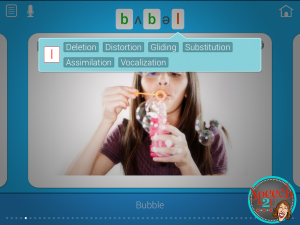
ITAP Scoring
Once you have finished the assessment, the ITAP will analyze your results, providing you with a standard score and a detailed report of errors including:
- Manner of Articulation (separated out by initial, medial, final)
- Transcription of the words and errors
- Error type which includes phonological processes and substitutions
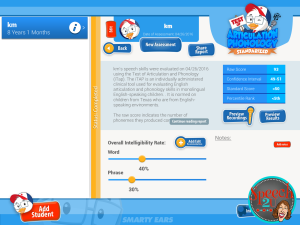
You can preview the results to add it into your report or there is a report that is generated based on the results. You have options to email the report as text or a PDF or print the report directly from your device.
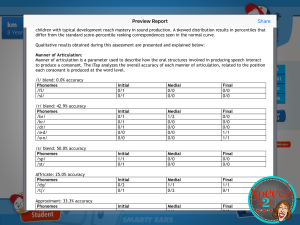
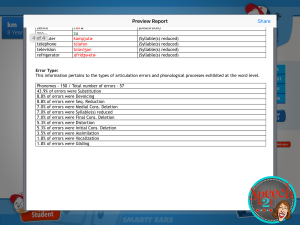
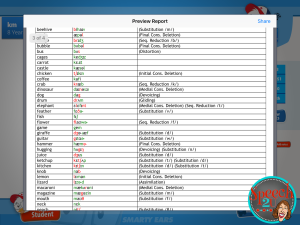
ITAP Review:
In general, I find articulation assessments to be fairly easy to administer. My subjects were very motivated to use the iPad for this assessment and named all of the pictures. It took about 25 minutes to administer the first time, but I could see that decrease-especially with clients with less articulation errors.
With digital assessments, you don’t have to worry about the coiled bindings coming undone, kids ripping or pulling off a page or stressing out about the child who WANTS to turn the pages. It’s pretty amazing. Can I share a personal pet peeve of mine? I hate turning pages. Not just on assessments-but also on regular books. It just seems like it takes a lot-especially if you are trying to eat and read a book at the same time. I love to read-but I’m pretty lazy at it.
Unlike the GFTA digital assessment, the iTap only requires one iPad to administer and it has a variety of interactive features. The GFTA digital assessment just includes the pictures. The ITAP is much more versatile in that it allows me to customize what I am doing as well as record my interpretations while I am giving the assessment. Plus I don’t have to remember the phonetic transcriptions.
The ITAP is the English speaking version of the BAPA (Bilingual Articulation and Phonological Assessment.) The BAPA was standardized on 438 children ages 3;0-10; 11 in the Central Texas Area. The standardization sample for English speaking only children was 199. You can read more about the standardization procedure by visiting the SmartyEars website. Standardizing articulation assessments has challenges because some articulation errors do not occur in the standard population and there is an age where we would expect that students make no errors. One question I had was, if you are customizing the app for the child does that change the validity of the standard score? For me, I think you always have to look at the total and type of errors to determine the need for services (duh, right?) For instance, a student could have errors that are atypical at any age (such as initial consonant deletion or having lateralized airflow.) In those cases, I would probably make a case for service, regardless of the standard score.
I wouldn’t use the report feature as we use electronic medical records at our clinic and I would not want to put client information in the report and email to myself. At school settings, I am usually using some type of IEP software as well. I think you could copy and paste some of the information into the report. I loved the error analysis for goal setting.
One other thing I experimented with when giving this assessment was inputting a client with /r/ only errors at age three vs. age ten. Results showed that the ITAP scoring accurately discriminated this developmental error:
- three year old /r/ error: standard score: 121
- ten year old /r/ error: below 50
What I loved:
- Ease of Administration (no page turning-yay!)
- Decreased time spent transcribing productions in error
- Error Analysis
- Interactive Features
- Full color photos
- Ability to customize feedback
What I would change:
- Increase standardization sample age to 18-21 years of age would increase the versatility of this assessment for clinicians who need standard scores for insurance purposes.
Bottom Line:
The ITAP app has a lot of good features that make it useful in the clinic and school setting. The cost of the app is 74.00. The BAPA adds Spanish articulation assessment and allows you to assess Spanish speaking students in both languages. The cost of this app was 99.00 at the time of this review. If you work in a diverse setting, I would definitely considering paying the extra money to purchase the BAPA. Want to learn more? Click on the buttons below to learn more.

